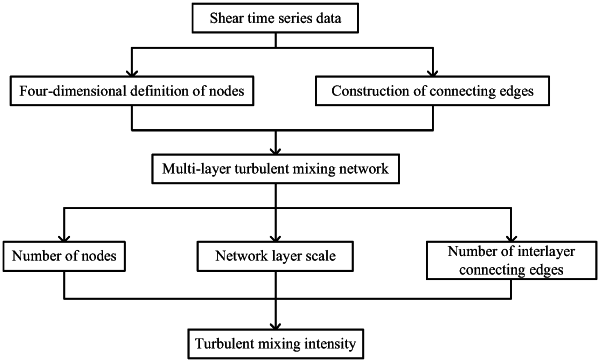| CPC G01C 13/002 (2013.01) | 7 Claims |

|
1. A method for calculating a turbulent mixing intensity, comprising following steps:
step 1: performing denoising preprocess on ocean spatiotemporal coupled shear profile data information obtained by a turbulence profiler;
step 2: constructing a multi-layer turbulent mixing network with topological attributes, wherein
the multi-layer turbulent mixing network comprises nodes and connecting edges; and
each node in the multi-layer turbulent mixing network is formed by fusion of four physical properties that comprise time series, scale data, energy local intermittency measure and phase, so as to realize topological representation of physical properties of multi-scale turbulent energy; and
recognizing a cross-scale transfer process of the turbulent energy according to a presence state of the connecting edges in the network;
wherein in the step 2, in a node definition stage, each node is defined by fusing the physical properties: the time series, the scale data, the energy local intermittency measure and the phase, based on multiple nonlinear processing methods, which comprises following substeps:
step 2.1: decomposing a nonlinear and unstable shear data signal s(t) into n intrinsic mode functions (IMFs) by empirical mode decomposition, with a decomposition formula as follows:
s(t)=Σni=1IMFi(t)+rn(t),
wherein IMFi(t) represents an ith intrinsic mode function, i∈[1, n], and rn(t) is a residual component;
step 2.2: calculating wavelet coefficients wa,b corresponding to different intrinsic mode functions by using wavelet transform;
quantifying energy distribution characteristics corresponding to the respective intrinsic mode functions, and representing scale attributes corresponding to the different intrinsic mode functions with ratios of a length of the time series corresponding to the shear data signal s(t) to zero-crossing values corresponding to the wavelet coefficients wa,b;
step 2.3: calculating a fluctuation of the energy local intermittency measure LIM based on the wavelet coefficients wa,b calculated in step 2.2, and identifying energy intermittent burst from the turbulent data according to LIM data, with a calculation formula as follows:
LIM=|wa,b|2/<|wa,b|2>b,
wherein LIM represents the energy local intermittency measure;
a represents scale information of the wavelet coefficients, b represents time scales corresponding to the wavelet coefficients; wa,b represents the wavelet coefficients, |wa,b| represents modulus values of the wavelet coefficients, and <•>b represents averaging process of the wavelet coefficients within time scale ranges b; and
step 2.4: calculating phase change attributes during different intrinsic mode fluctuations,
thereby completing topological definition of the nodes, wherein the nodes with different scale attributes are distributed in different network layer structures; wherein in the step 2, construction of the connecting edges is completed based on the physical properties contained in the nodes, which is as follows:
when two nodes with different scale attributes at a same time have energy local intermittency fluctuations being in a peak and beyond a mean value, and a fluctuation phase difference is less than a predetermined fluctuation phase difference threshold, there exists a connecting edge between the two nodes, that is, there exists the cross-scale transfer process of the turbulent energy between vortices of different scales represented by the two nodes; and
when two nodes with different scale attributes at a same time have energy local intermittency measures that are not all in the peak or some of which are below the mean value, or a fluctuation phase difference is greater than a predetermined fluctuation phase difference threshold, there does not exist the connecting edge between the two nodes, that is, there does not exist the cross-scale transfer process of the turbulent energy between the vortices of different scales represented by the two nodes, and
step 3: performing parametric calculation of the turbulent mixing intensity according to the topological attributes of the multi-layer turbulent mixing network;
wherein the step 3 comprises:
analyzing the constructed multi-layer turbulent mixing network, and obtaining the topological attributes of the multi-layer turbulent mixing network that comprise a number of nodes in each layer in the network structure, network layer scale attributes and a number of interlayer connecting edges, wherein
the number of nodes in each layer in the network structure refers to a number of sampling points contained in the shear data signal s(t), and the network layer scale attributes refer to the ratios of the length of the time series corresponding to the shear data signal s(t) to zero-crossing values corresponding to the wavelet coefficients; and
the number of interlayer connecting edges refers to the number of connecting edges constructed between two adjacent network layers upon meeting connecting edge construction conditions; and
calculating a turbulent mixing intensity κ depending on the topological attributes, with a formula as follows:
 wherein N represents a total number of nodes contained in each network layer in the multi-layer turbulent mixing network;
α and β represent two adjacent network layers, eαβ represents a number of connecting edges between adjacent network layers α and β, and Sα and Sβ represent respective scale attributes of the two adjacent network layers α and β; and
L represents a network layer set, and αβ⊂L represents that α and β are network layers in the network layer set L.
|